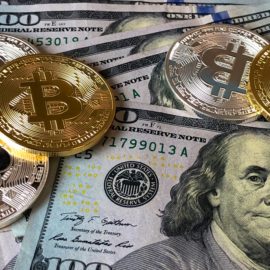

This article is an excerpt from the Shortform book guide to "The Bitcoin Standard" by Saifedean Ammous. Shortform has the world's best summaries and analyses of books you should be reading.
Like this article? Sign up for a free trial here.
What is Saifedean Ammous’s The Bitcoin Standard about? What is the key message to take away from the book?
In The Bitcoin Standard: The Decentralized Alternative to Central Banking, Saifedean Ammous suggests that bitcoin has the potential to become a new monetary standard. To make this argument, he explains the problems fiat money creates, and how bitcoin can solve these problems.
Below is a brief overview of the book.
What the Bitcoin Standard Would Look Like
In his book The Bitcoin Standard: The Decentralized Alternative to Central Banking, Saifedean Ammous envisions a future in which bitcoin may become the world’s international reserve currency, much as gold was in the 19th century. Under the gold standard, most countries pegged the value of their currencies to gold. A US dollar bill or a British pound note could be redeemed for a fixed quantity of gold, if desired. But Ammous says that in practice, few people carried gold money.
Instead, he says they used paper bills, bank notes, or checks for most transactions, while the actual gold remained in bank vaults. Of course, these bills, notes, and checks ultimately ended up in banks, resulting in banks owing each other money as their respective depositors did business with each other. Periodically, banks would ship gold bullion to each other to reconcile their debts, but a given bank might process thousands of deposits and withdrawals in bills and checks every time they sent or received a shipment of gold.
Similarly, Ammous explains that under a bitcoin standard, people would carry out most transactions using national or digital currencies whose value was pegged to bitcoin, rather than using bitcoins directly. Banks or other financial institutions would process these transactions and then settle their debts with each other using bitcoin, just as they used to do with gold. But whereas shipping gold from one bank to another was costly and time-consuming, especially if the banks were in different countries or on different continents, bitcoin transactions take only a few minutes and are unaffected by geographical distance and national boundaries.
Ammous doesn’t necessarily predict that the world will adopt a bitcoin standard, but he argues that a bitcoin standard has the potential to bring greater global economic prosperity because bitcoin has a number of properties that make it—at least potentially—a better form of money than anything that’s been used as money in the past. We’ll discuss these properties in detail later in this guide.
Problems With Fiat Money
Ammous believes a Bitcoin Standard would be good for the global economy because it offers a solution to the problems of fiat currency—money that derives its value solely from government decree, like US dollars, British Pounds, or most other national currencies in use today. We’ll discuss the social and economic problems that Ammous says fiat money causes and how bitcoin could solve those problems.
Economic Problems That Fiat Money Exacerbates
Ammous points out that fiat money facilitates inflation, which gives people incentive to spend their money instead of save it. If the government expands the money supply, the value of money decreases in proportion to the increase in supply—a process we refer to as inflation. Inflation discourages saving because savings lose value over time. Ammous argues that savings are a good predictor of long-term economic performance because savings allow a society to build durable infrastructure. So, over the long term, a lack of savings leads to fragile infrastructure and poor economic performance.
He also asserts that fiat money and the central banking systems that promulgate it artificially lower interest rates, enticing people and businesses to borrow money for risky business ventures. This increases the fraction of business ventures that fail, reducing economic stability, increasing unemployment, and wasting resources.
(Shortform note: In The Creature from Jekyll Island, Edward Griffin elaborates on this principle. He explains that the practice of fractional lending—where banks hold only a fraction of their deposits on hand and lend out the rest—increases the money supply, which reduces the cost of capital and thus depresses interest rates. According to Griffin, not only do these low interest rates encourage businesses to borrow money for risky investments, but government protections like deposit insurance, bailouts, and the option to borrow money from the Federal Reserve encourage banks to make risky loans.)
Social Problems That Fiat Money Exacerbates
Ammous further explains that, in principle, fiat money allows a government to spend all the resources of all its citizens, not just the funds that it collects in taxes or other revenue. This is because the government can finance any project just by printing more money. This has the same effect as a tax, since it takes value away from the people by devaluing their money, but usually people don’t perceive it as a tax.
Ammous argues that this is particularly problematic in war because it means nations can fight each other until they’ve completely exhausted the resources of their entire respective populations, not just until the government has exhausted its treasury. He points to World War I as an example of one of the first wars fought with fiat money, and conjectures that the war would have been resolved sooner and with less bloodshed if countries had stayed on the gold standard.
Why Bitcoin Is Beyond Government Control
Ammous explains that the decentralized architecture of the bitcoin network is what makes it impossible for any government to control: The system is designed so that every transaction has to be verified and approved by a majority of the network.
Consequently, anyone who wanted to alter how bitcoin works (for example, to increase the supply of bitcoins, or to disallow certain transactions) would have to control a majority of the network. And no single country, let alone any government agency, has control over enough of the network to make changes. This ensures that bitcoin will continue to operate the same way (and with the same controls on its supply) regardless of the wishes of national governments.
Why Bitcoin Makes Good Money
Now that we’ve discussed how bitcoin avoids the problems fiat money poses, let’s examine how bitcoin is generally a good form of money and has the potential to become the new monetary standard.
Ammous explains that there are two properties that determine how suitable something is for use as money: ‘salability’ and ‘hardness.’ Then there’s the issue of trust in the payer: The form of money can influence the likelihood of a transaction failing due to nonpayment. We’ll discuss each of these factors in turn to show why Ammous thinks bitcoin makes good money.
Bitcoin Has Good Salability
As Ammous uses the term, ‘salability’ is the ability of something to transmit value. He says there are three dimensions to salability: scale, space, and time.
Scale-Salability
The scale-salability of something is its ability to transmit value between purchases of different size. For example, maybe you sell something of great value, like a house, and then you want to use a little bit of the money from the sale to purchase something of small value, like a loaf of bread. The scale-salability of something that is used as money depends mostly on how easily divisible it is into units of different value.
Bitcoins have excellent scale-salability because they’re easily divisible in practice: The bitcoin network supports transactions as small as 0.00000001 bitcoin. So you could sell a house for 25 bitcoins and buy a loaf of bread for 0.00015 bitcoins without any trouble.
Space-Salability
The space-salability of something is its ability to transmit value over geographical distances. For example, maybe you want to sell a house in New York and buy one in Colorado. If your buyer offered to pay in either gold or cattle (both of which Ammous notes have historically been used as money), it would be much easier to carry 250 gold coins with you across the country than to transport 250 head of cattle. As such, gold has much better space-salability than cattle.
Bitcoins have excellent space-salability because they only exist as entries in a digital ledger, which is stored redundantly on many “nodes” throughout the world and accessed via the internet. So you can access your bitcoins from anywhere in the world, provided you can connect to the internet.
(Shortform note: Some economists argue that bitcoin has too much space-salability. For example, in A Random Walk Down Wall Street, Burton Malkiel opines that bitcoin is an ideal medium in which to carry out illegal transactions because bitcoin facilitates easy, anonymous, irreversible transactions without respect to national boundaries. As such, he conjectures that sooner or later, most governments around the world will take steps to shut down the bitcoin network as a means of fighting crime, after which the value of bitcoins will drop to zero. He thus advises against investing in bitcoin, as he sees its current value as a bubble that will eventually break.)
Time-Salability
The time-salability of something is its ability to transmit value across time. For example, maybe you want to save up for a big purchase over a period of years or decades. Ammous warns that if you try to save up your money in dollars or other fiat currency, your savings will lose value over time due to inflation.
At present, bitcoin’s time-salability is not as good as its scale-salability or space-salability because its value fluctuates unpredictably. Ammous discusses several factors that contribute to bitcoin’s volatile price.
For one thing, bitcoins exist only as a digital currency, whereas many other things that have been used as money have commercial uses that give them tangible value to begin with. For example, the price of gold never drops below a certain threshold because of the commercial demand for gold to be used in making jewelry and certain electrical components. Bitcoins don’t have this basic commercial value, so their value can fluctuate more erratically.
For another thing, the price of bitcoin is the only factor that can adjust to match supply with demand because the supply of bitcoin at any given time is fixed. By contrast, both supply and price are variable for most other goods. When the demand for a commodity rises, driving up prices, the higher prices motivate producers to increase production. This increase in supply helps to balance out the increased demand, so the price doesn’t rise as much.
So too, if the demand for a commodity drops, prices start to drop, and suppliers cut back on production. But because the supply of bitcoin is fixed, its price fluctuations can’t be ameliorated by increases or decreases in supply, so its price will fluctuate more dramatically in response to fluctuations in demand.
Ammous observes that the effect of demand fluctuations is amplified by the relatively small market for bitcoins and by the temperament of the people who hold them: Many bitcoin holders tend to buy or sell large quantities of bitcoin, depending on whether they think the price will go up or down. This results in proportionately larger fluctuations in demand for bitcoin relative to other currencies and commodities.
However, Ammous also contends that this could change. If the bitcoin market continues to grow, demand may become less volatile. And if central banks build stockpiles of bitcoin to back other currencies (which is an important step toward adopting a Bitcoin Standard) this would also tend to stabilize the value of bitcoins.
Bitcoin Is Hard Money
As we’ve discussed, bitcoin’s time-salability isn’t ideal because bitcoin’s value tends to fluctuate, but Ammous asserts that despite these short-term fluctuations, bitcoin does have good time-salability in the long run because it is a very “hard” currency, and thus does not lose value due to inflation. In this section we’ll discuss the “hardness” of money, which is another factor that, along with salability, determines how good a type of money is.
Ammous explains that the “hardness” of a type of money is the ratio of the total quantity in circulation to the maximum amount that could be added in a given amount of time, usually one year.
For example, wheat has a very low hardness, because it is produced and consumed every year, and so the total supply is about the same as the annual production. By contrast, gold has a very high hardness, because it is relatively scarce and humans have been stockpiling it for thousands of years, so the amount of gold produced by gold mines in any given year is only a tiny fraction of the world’s total gold supply.
Bitcoin is designed such that bitcoins are added to circulation at a predictable rate that is halved every four years, and will cease altogether once the total number in circulation reaches 21,000,000 bitcoins. Thus, bitcoin has a high hardness, and that hardness will continue to increase until all the bitcoins are in circulation, at which point its hardness will become infinite.
(Shortform note: As of 2022, over 90% of the 21,000,000 total bitcoins are already in circulation, and the rate of growth is about 328,500 bitcoins per year, or 1.7% per year. For comparison, the world supply of gold is about 200,000 tons, and global gold production is about 3,200 tons per year, or 1.6%, so bitcoin already has comparable “hardness” to gold.)
Hard Money Prevents Inflation From Redistributing Wealth
Ammous demonstrates the importance of hard money by observing what happens to a society that uses money with low hardness: Over time, all the real value in that society goes to those who provide the supply of money.
As Ammous explains, this is because there’s always a demand for any material that a society uses as money (such as gold or silver), which motivates people to produce it (for example, by mining gold). Yet, increasing the money supply decreases the value of the money that’s already in circulation.
It takes time for the economy to adjust to changes in the value of money, so when producers of money (such as gold miners) sell their product, they receive more payment for it than it will be worth once the economy adjusts to the increased money supply. This is what allows the producers of money to accumulate a greater and greater fraction of society’s real wealth over time.
If the society uses hard money, such as gold or bitcoin, the magnitude of this effect is small. But it gets larger the faster the money supply increases. For example, if the money supply abruptly doubles, then the value of money will be cut in half, so the people who increased the supply will acquire half of the total value that the money supply represented before it doubled.
Bitcoin Is Based on Verification Instead of Trust
Ammous asserts that the final desirable characteristic of bitcoin is its system of complete verification, which eliminates the need for trust.
He explains that many other types of transactions require a degree of trust: If someone writes you a check, you’ll only accept it as payment if you trust that their check won’t bounce. If someone pays you with a credit card, the credit card company acts as a trusted third party, verifying her credit and guaranteeing payment of her debts. But that means the credit card company can block any transaction that it disapproves of, even if the payer and the payee both approve of it. But with bitcoin, there’s no need to trust either the payer or a third party because of its system of complete verification.
Complete verification means that the network first checks to make sure the payer can make the payment (they have sufficient funds in their account) and then irreversibly transfers the funds, ensuring that the payer does make the payment. Furthermore, these checks are performed not just by a single payment processor, but by a majority of the network—a large number of independently-operated servers all over the world. To default on a payment or make a fraudulent payment, the payer would have to gain control of a majority of the entire bitcoin network, which, as we’ve discussed, would be virtually impossible. This is how the network ensures that the payer can’t default, eliminating the need for trust.
Ammous points out that this is ideal for settlements between parties located in different countries, who might have limited options for enforcing an agreement to pay. It also means that all bitcoin transactions are final, irreversible, and immune to third-party stipulations, much like paying someone in cash or gold.
But, as Ammous concedes, this approach also creates a large amount of redundancy (relative to using a trusted third party like a credit card company) since each transaction is independently verified by a majority of the entire network, not just a single server. This redundancy reduces the efficiency and speed of processing transactions.
What the Bitcoin Standard Doesn’t Look Like
We’ve discussed the properties of bitcoin that arguably make it an ideal form of money and allow it to solve some of the problems with common fiat currencies. And we’ve laid out Ammous’s vision for a global bitcoin standard in which banks use bitcoin as an international reserve currency, much like they once used gold. But if bitcoin is a superior form of money, why would only banks use it for settling their debts? Why wouldn’t we all just switch to using bitcoins directly? Ammous explains that there are two reasons bitcoin will never be a global currency for day-to-day transactions.
First, as digital transactions go, bitcoin is slow. It takes about 10 minutes for a bitcoin transaction to clear. If you’re running a grocery store and have people in line to check out, you can’t wait 10 minutes for each payment to go through.
Second, bitcoin can’t handle a high enough volume of sales. The bitcoin network can only handle about half a million bitcoin transactions per day. That’s enough to cover large balance settlements between banks throughout the world, but not enough to cover all commercial transactions: A single major credit card company may need to process hundreds of millions of transactions per day.
These limitations are inherent in the design of bitcoin, so scaling up the bitcoin network as more people adopt cryptocurrency won’t appreciably increase the transaction speed or the number of transactions that can be completed per day.

———End of Preview———
Like what you just read? Read the rest of the world's best book summary and analysis of Saifedean Ammous's "The Bitcoin Standard" at Shortform.
Here's what you'll find in our full The Bitcoin Standard summary:
- Why bitcoin has the potential to replace the gold standard
- What makes bitcoin stronger than fiat money
- Why bitcoin will never be a global currency for day-to-day transactions






